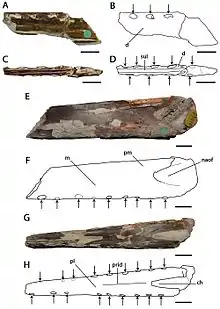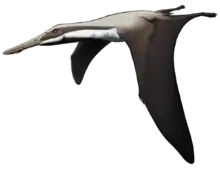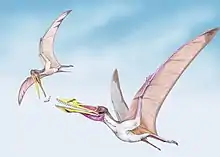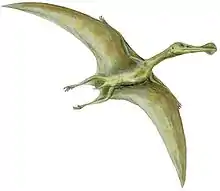Lonchodectes
Lonchodectes (meaning "lance biter") was a genus of lonchodectid pterosaur from several formations dating to the Turonian (Late Cretaceous) of England, mostly in the area around Kent. The species belonging to it had been assigned to Ornithocheirus until David Unwin's work of the 1990s and 2000s.[1] Several potential species are known; most are based on scrappy remains, and have gone through several other generic assignments. The genus is part of the complex taxonomy issues surrounding Early Cretaceous pterosaurs from Brazil and England, such as Amblydectes, Anhanguera, Coloborhynchus, and Ornithocheirus.[2]
| Lonchodectes | |
|---|---|
 | |
| Holotype jaw fragment | |
| Scientific classification | |
| Kingdom: | Animalia |
| Phylum: | Chordata |
| Order: | †Pterosauria |
| Suborder: | †Pterodactyloidea |
| Clade: | †Ornithocheiromorpha |
| Family: | †Lonchodectidae Hooley, 1914 |
| Genus: | †Lonchodectes Hooley, 1914 |
| Type species | |
| †Pterodactylus compressirostris Owen, 1851 | |
| Species | |
| |
| Synonyms | |
| |
History and species

Numerous species have been referred to this genus over time, and only those more widely connected with the genus are included here.
The type species, L. compressirostris, is based on NHMUK 39410, a partial upper jaw from the Turonian-age Upper Cretaceous Upper Chalk near Kent. Richard Owen named in 1851 as a species of Pterodactylus;[3] it was transferred to Ornithocheirus in 1870 by Harry Govier Seeley,[4] before becoming the type species of Lonchodectes in Reginald Walter Hooley's 1914 review of Ornithocheirus.[5] Confusingly, this species was also long regarded, incorrectly, as the type species of Ornithocheirus.[6]
A variety of postcranial remains resembling those of Azhdarchoids from the Cambridge Greensand have been referred to Lonchodectes;[6][7][8] however, much of this material has since been referred to Ornithostoma.[9]
Formerly assigned species

Hooley added two other species at this time, both of which had also been originally referred to Pterodactylus, then to Ornithocheirus: L. giganteus, a Cenomanian-age jaw fragment from the Chalk of Kent;[10] and L. daviesii, another jaw fragment, from the Albian-age Gault Clay.[11]
"Pterodactylus" sagittirostris, based on NHMUK R.1823, a lower jaw fragment from the ?Valanginian-Hauterivian-age Lower Cretaceous Hastings Beds of East Sussex,[11] "Ornithocheirus" platystomus,[4] "Ornithocheirus" machaerorhynchus, and "O." microdon were assigned to Lonchodectes in a 2001 review by David Unwin of Cambridge Greensand pterosaurs.[6] joining L. compressirostris, L. giganteus, L. platystomus, and L. sagittirostris in his listing of valid species.[12] However, L. giganteus, L. machaerorhynchus, and L. microdon have since been assigned to a new genus, Lonchodraco, while L. sagittirostris has been renamed Serradraco.[2][13] L. platystomus may be a species of Amblydectes.[2] In 2020, a review of Lonchodectidae was conducted by paleontologist Alexander Averianov, where he reassigned the species L. machaerorhynchus to the genus Ikrandraco due to similarities in rostral morphology, as I. machaerorhynchus, and he also considered L. microdon a junior synonym of machaerorhynchus. Therefore, Lonchodectes is limited to its type species, L. compressirostris.[14]
Classification


In Peter Wellnhofer's 1991 The Illustrated Encyclopedia of Pterosaurs, written before Unwin's work, the species were included within Ornithocheirus (because of L. compressirostris being thought to be the type species), and are in fact the main fossils illustrated to represent the genus.[15] In 2003, Unwin placed them in their own family, Lonchodectidae, which he grouped within the group Ctenochasmatoidea,[16] while in 2006, he placed the family Lonchodectidae within the Azhdarchoidea, the group that includes the tapejarids and azhdarchids.[12]
The cladogram below is a topology recovered by Longrich and colleagues in 2018. In their analysis, they placed Lonchodectes within the family Lonchodectidae as the sister taxon of Lonchodraco. Contrary to previous analyses, Longrich and colleagues placed Lonchodectidae (including Lonchodectes) within the more inclusive group Ornithocheiromorpha.[17]
| Ornithocheiromorpha |
| |||||||||||||||||||||||||||||||||||||||||||||||||||||||||||||||
Paleobiology

Lonchodectes had long jaws with many short teeth, and the jaws were compressed vertically, like "a pair of sugar tongs with teeth".[18] Related species (including several taxa formerly included within the genus) had crests on their lower jaws, so the same probably also applied to L. compressirostris.[19]
References
- Kellner, A.W.A. (2003). Pterosaur phylogeny and comments on the evolutionary history of the group: In: Buffetaut, E., and Mazin, J.-M. (Eds.). Evolution and Palaeobiology of Pterosaurs. Geological Society Special Publication 217:105-137. 1-86239-143-2.
- Rodrigues, T.; Kellner, A. (2013). "Taxonomic review of the Ornithocheirus complex (Pterosauria) from the Cretaceous of England". ZooKeys 308: 1. doi:10.3897/zookeys.308.5559. edit
- Owen, R. (1851). Monograph on the fossil Reptilia of the Cretaceous Formations. The Palaeontographical Society 5(11):1-118.
- Seeley, H.G. (1870). The Ornithosauria: an Elementary Study of the Bones of Pterodactyles. Cambridge, 130 pp.
- Hooley, R.W. (1914). On the Ornithosaurian genus Ornithocheirus with a review of the specimens from the Cambridge Greensand in the Sedgwick Museum, Cambridge. Annals and Magazine of Natural History, series 8, 78:529-557.
- Unwin, David M. (2001). "An overview of the pterosaur assemblage from the Cambridge Greensand (Cretaceous) of Eastern England". Mitteilungen aus dem Museum für Naturkunde in Berlin, Geowissenschaftliche Reihe. 4: 189–222.
- Unwin, D.M. (2008)
- Pterosaurs: Natural History, Evolution, Anatomy, Mark P. Witton (2013)
- Averianov, A.O. (2012). "Ornithostoma sedgwicki – valid taxon of azhdarchoid pterosaurs." Proceedings of the Zoological Institute RAS, 316(1): 40–49.
- Bowerbank, J.S. (1846). On a New Species of Pterodactyl. Found in the Upper Chalk of Kent (P. giganteus). Quarterly Journal of the Geological Society 2:7–9.
- Owen, R. (1874). A Monograph on the Fossil Reptilia of the Mesozoic Formations. 1. Pterosauria. The Palaeontographical Society Monograph 27:1–14.
- Unwin, D.M. (2006). The Pterosaurs: From Deep Time. Pi Press:New York, p. 273. ISBN 0-13-146308-X.
- Stanislas Rigal; David M. Martill; Steven C. Sweetman (2017). "A new pterosaur specimen from the Upper Tunbridge Wells Sand Formation (Cretaceous, Valanginian) of southern England and a review of Lonchodectes sagittirostris (Owen 1874)". In D. W. E. Hone; M. P. Witton; D. M. Martill. New Perspectives on Pterosaur Palaeobiology. The Geological Society of London. doi:10.1144/SP455.5.
- Averianov, A.O. (2020). "Taxonomy of the Lonchodectidae (Pterosauria, Pterodactyloidea)". Proceedings of the Zoological Institute RAS. 324 (1): 41–55. doi:10.31610/trudyzin/2020.324.1.41.
- Wellnhofer, Peter (1996) [1991]. The Illustrated Encyclopedia of Pterosaurs. New York: Barnes and Noble Books. pp. 110–113. ISBN 0-7607-0154-7.
- Unwin, David M. (2003). "On the phylogeny and evolutionary history of pterosaurs". In Buffetaut, Eric; Mazin Jean-Michel (eds.). Evolution and Palaeobiology of Pterosaurs. Geological Society Special Publication 217. London: Geological Society. pp. 139–190. ISBN 1-86239-143-2.
- Longrich, N.R., Martill, D.M., and Andres, B. (2018). "Late Maastrichtian pterosaurs from North Africa and mass extinction of Pterosauria at the Cretaceous-Paleogene boundary." PLoS Biology, 16(3): e2001663. doi:10.1371/journal.pbio.2001663
- Unwin, D.M. (2006). The Pterosaurs: From Deep Time. Pi Press:New York, p. 251. ISBN 0-13-146308-X.
- Unwin, D.M. (2006). The Pterosaurs: From Deep Time. Pi Press:New York, p. 106. ISBN 0-13-146308-X.
External links
- Re: Pterosaur Help, a posting from George Olshevsky on the Dinosaur Mailing List, which, although incomplete, should give some idea as to the complexity of the taxonomy here. Additional, even more dubious species are included. Accessed 2007-02-10













